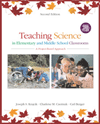 |  Teaching Children Science: A Project-Based Approach, 2/e Joe Krajcik,
University of Michigan - Ann Arbor
Charlene Czerniak,
University of Toledo
Carl Berger,
University of Michigan - Ann Arbor
How Do Children Construct Understanding in Science?
Chapter Summary- Meaningful understanding results when learners have built relationships among ideas, can explain these relationships, and can use their ideas to explain and predict phenomena.
- School science often results in students developing inert knowledge -- disconnected, unusable fragments of ideas.
- Project-based science leads to students developing meaningful understandings.
- To develop meaningful understanding, students need to develop content, procedural, and metacognitive knowledge.
- Children construct meaning through their interactions with and interpretations of their world, including essential interactions with others.
- The features of social constructivist teaching include
- active engagement in phenomena,
- use and application of knowledge,
- multiple representations,
- use of learning communities, and
- authentic tasks.
- Language serves as a tool to develop understanding.
- Teachers scaffold students so they can engage in tasks just out of their cognitive reach.
- Teachers can scaffold learners by
- modeling,
- coaching,
- sequencing,
- reducing complexity,
- marking critical features, and
- using visual tools.
- Tasks in school need to be authentic to have meaning.
- Four aspects of authentic tasks are
- the driving question,
- the relevance of a question or topic to students,
- the connection of learning to students' lives outside of school, and
- the emergence of science concepts and principles when they are needed.
- Technology tools extend learning in science classrooms.
|
|



 2003 McGraw-Hill Higher Education
2003 McGraw-Hill Higher Education